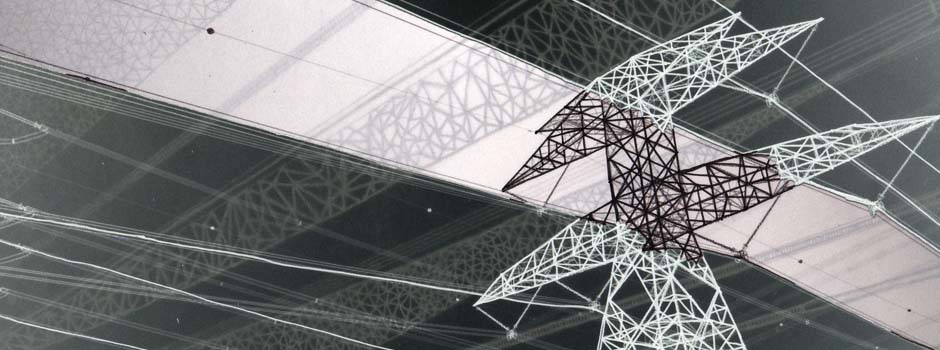
The debut exhibition of Jessica Mein in the Middle East
Jan 08, 2012 Exhibition
Mein takes the viewer through her works in her search for a moment where time dilates and compresses, and the tempo of experience is altered. Repetition with small deviation and occasional error intentionally point us to the “difference between objects represented by the same concept, falling into indifferences of space and timeâ€, as described by French philosopher Gilles Deleuze (1925 – 1995). Her animations often resemble deconstructed and layered states of dreaming and remembering with time woven in-between and randomly looped; where space and time become inseparable.
Image above: Jessica Mein, Blackout, 2011, animation, still12 / Image: Courtesy of The Pavilion Downtown and The Artist.
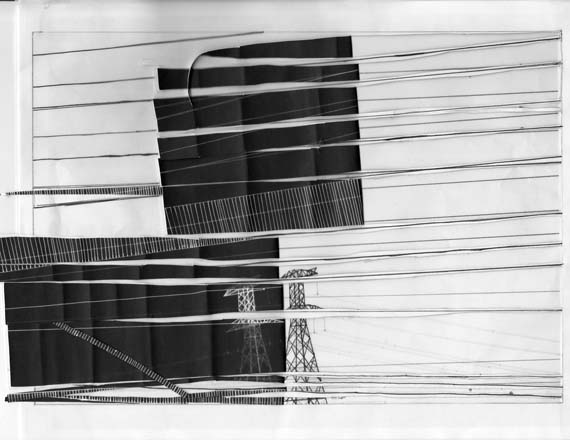 Jessica Mein, Blackout, 2011, animation, still1 / Image: Courtesy of The Pavilion Downtown and The Artist.
Jessica Mein, Blackout, 2011, animation, still1 / Image: Courtesy of The Pavilion Downtown and The Artist.
Mein will present her new video animation Blackout, where she uses visual material of power lines in the city of Dubai and its surroundings. The process of making - through paper splicing, cutting, bending, and overlaying – is the focus of the new two-minute looped animation consisting of more than 700 drawings, collages, over-layered stills, and cut-paper manipulations of images and drawings of the power-lines from the city. The non-narrative progression from white horizon to black - using line repetition, negative space and mirror drawing - makes it a nearly abstract animation, marking a new direction in Mein’s practice.
The powerlines and towers slide and collapse, revealing patches of blue sky and exposing new collaged layers that cross, break, explode, and become connected again by the fine lines of drawing. The synthesis of the mechanical and the hand-made is explored on a different level; cutting paper is used as a way of drawing. Digitally produced, the color of the sky is used along with the mechanically produced black of the printer, and bound with fine drawing lines that are later again physically cut. This process creates stripes and layers of superimposed spaces and arrives at the “in-betweeness” of the still and the moving image. The synthesis of what is produced by hand, eye, and mind makes us turn to examine the function of vision and memory in the context of the human body. The intensity of this saturation is fully seen in the total blackout, where the intentional overlaying and concentration of hundreds of power lines creates an unexpected startling vision of blackness bringing out materiality of paper - effectively depositing the observer, for a few seconds, in the interstice between the human and the mechanically made.
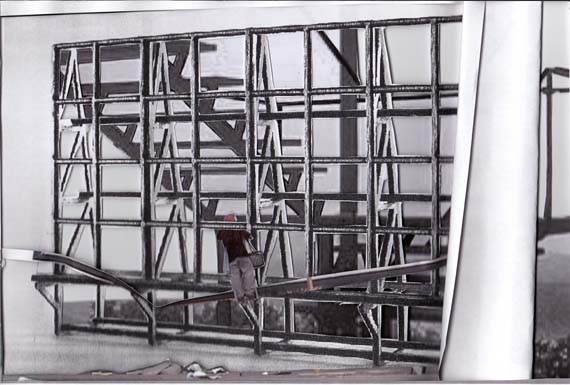 Jessica Mein, Billboard 2010, animation, still2 / Image: Courtesy of The Pavilion Downtown and The Artist.
Jessica Mein, Billboard 2010, animation, still2 / Image: Courtesy of The Pavilion Downtown and The Artist.
The exhibition also includes four other animations: Billboard (2010), originates from the artist’s interest in the increasingly obsolete paper billboards from her hometown of São Paulo. Using discarded billboard prints as a primary source material, Mein concentrates on its errors, glitches and folds in a densely layered animation, projected onto a single crumpled piece of paper - depicting the material of a billboard. She has recorded a laborer ascending and descending a ladder as he pastes sheets to an advertising hoarding, an activity which was recently outlawed in the city. In Natureza Morta, (2009), the every day setup of a fruit vendor in a rural town in Argentina is combined with excerpts taken from still life paintings of fruit - from works by both renowned masters and anonymous painters. The material is then painstakingly collaged and drawn upon, and ultimately compressed into a single animation.
Cegueira (2008), is the story of a Venetian blind: when pulled up and down it performs as a metronome and theatrical curtain – as that of a voyeuristic outlook. Made up of over 600 hand made drawings, collages and photographs set into motion, the video interlace also corresponds with the physical properties of the images and their movements, as an intangible layer between the screen and what is behind it, which is created through drawing, cutting and re-layering the images.
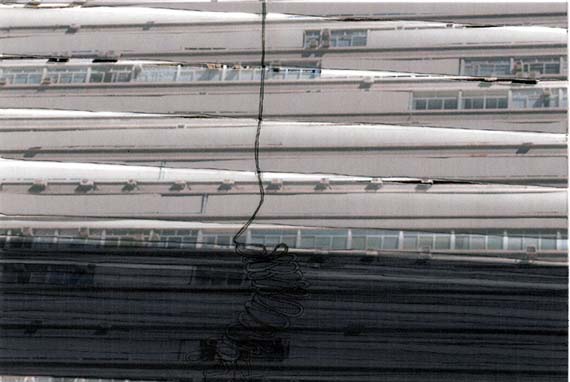 Jessica Mein, Cegueira, 2008, animation, still1 / Image: Courtesy of The Pavilion Downtown and The Artist.
Jessica Mein, Cegueira, 2008, animation, still1 / Image: Courtesy of The Pavilion Downtown and The Artist.
Mein is more interested in the structure of storytelling and its materiality, rather than its actual narrative and her works on paper address and index this structuring more concretely, foregrounding their labor with a stillness absent from the animated works. Error, accident and imperfection are all implicit in these processes, which reference the development of time, precarious structures, as well as limitations inherent to the medium. It is the abstraction of representation, together with a physical handling of images that is at the core of Mein’s practice.
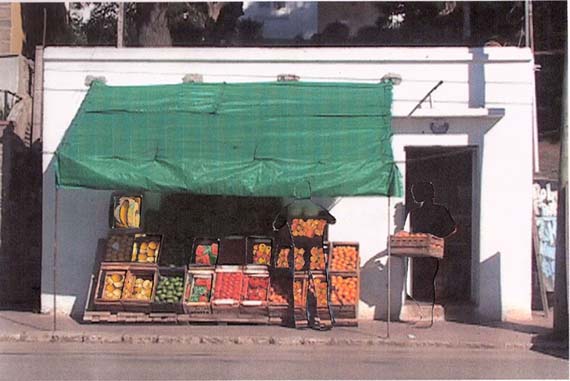 Jessica Mein, Natureza Morta, 2009, animation, still4 / Image: Courtesy of The Pavilion Downtown and The Artist.
Jessica Mein, Natureza Morta, 2009, animation, still4 / Image: Courtesy of The Pavilion Downtown and The Artist.
Born in 1975 in São Paulo, Brazil. Lives and works between Dubai, New York and São Paulo. Mein works across media mainly focusing on drawing, collage, books and animation. She holds MFA degree from Hunter College and BA from Duke University. Mein’s solo shows to date include: Verso Reverso, Simon Preston Gallery, NYC (2011); Cegueira, Gallery Pfeister, Denmark (2010); and Natureza Morta, Tony Wright Gallery, Chicago, USA (2009); Feldman Gallery Project Room, Pacific Northwest College of Art, Portland, USA (2009); Simon Preston Gallery (with Carlos Bevilacqua), New York, NY, USA (2008). She recently participated in group exhibitions at the Drawing Center and the Big Screen Project, New York, USA (2011). Mein’s works are included in prestigious public collections such as The Museum of Modern Art, New York, USA; and Julia Stoschek Foundation, Dusseldorf, Germany.
Kolesnikova is an independent curator, an art advisor, and the founder of Perceptions Fine Art Consulting. Born in 1974 in Russia and now based in Dubai, she has been working between the USA, Russia and UAE. With an MA in Western Literature from St. Petersburg State University, she has been an active contributor to the development of the UAE art scene. As a curator, Kolesnikova focuses on emerging and mid-career international artists and introducing them to the audience of the MENA region, broadening the geographic horizon of the regional art scene and promoting international dialogue. Her recent curatorial projects include solo exhibitions by German artist Carolin Kropff, with UBER-Construction at The Pavilion Downtown Dubai, (2011), and FATAMORGANA, at XVA Gallery, Dubai, UAE (2010).
The Pavilion Downtown Dubai is the city’s newest dedicated non-profit contemporary art space providing a place to view, discuss and participate in works by local and international artists. Developed by the multidivisional group Cultural Engineering, The Pavilion is a unique hub for a diverse range of art events offering a platform to promote an active arts community to the public and to support the work of a rising generation of artists in the region. The Pavilion’s programming will reinforce its role as a place for artistic discourse, research and education. The building itself reflects a unique interior that supports a dialogue between art and its audience. The Pavilion includes two art galleries, a restaurant, a cinema, a library, an espresso bar, a shisha café and lounge.
Comments
Add a comment